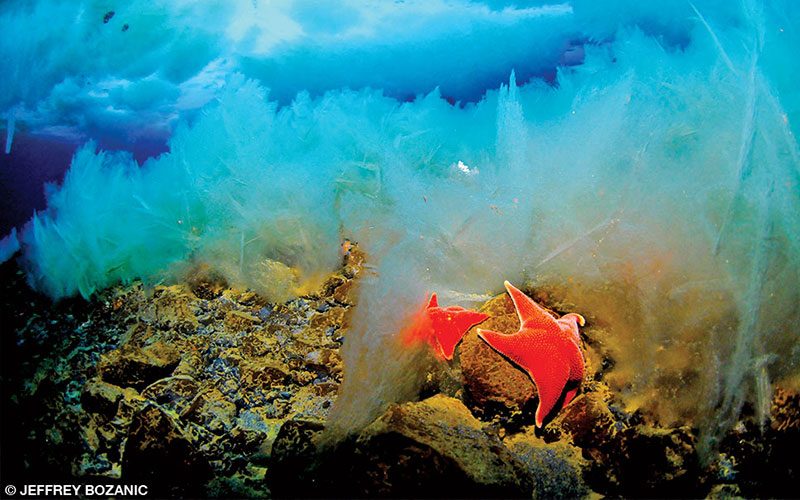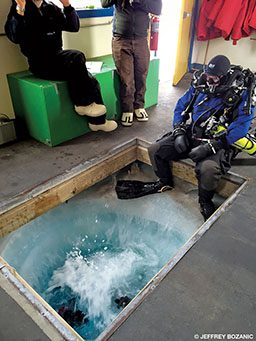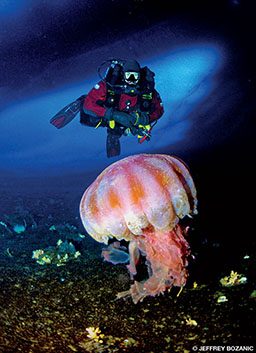I can feel ice crystals hitting my teeth as I inhale. They are small and insignificant, but vibration and a rattling sound deeper inside the mouthpiece warn of larger ice fragments in the breathing hoses and mouthpiece chamber. I wonder if they will cause more serious issues than the slight inconvenience of the crystals that strike my teeth as I gaze at a row of ice stalactites 400 feet away. To ease my concern, I fin closer to the hole that leads to the surface, marveling at the vista surrounding me under Antarctica’s ice-shrouded ocean.
I am at McMurdo Station, the largest research base on Antarctica. Run by the United States, McMurdo supports a research diving program funded by the National Science Foundation. John Heine, the diving safety officer for the U.S. Antarctic Program, has assembled a team of divers including Rob Robbins, Steve Rupp, Christian MacDonald, Brenda Konar and me to test rebreathers in polar diving conditions.
The first recorded American scuba dive in Antarctica took place in 1947 as part of Operation Highjump, a U.S. Navy research program. Scuba diving in the U.S. Antarctic Program grew through the late 1950s and 1960s until it was a regular part of research operations during the 1970s, and it continues to the present day. This diving, however, was conducted using open-circuit scuba equipment, first with double-hose regulators and later with single-hose apparatus.

Bubbles emitted by open-circuit equipment impair divers’ ability to conduct certain types of observations. The same bubbles potentially have adverse effects on some Antarctic environments. Rebreathers offer significant advantages in these respects, as the volume of gas they expel is negligible in most circumstances.
There is no institutionalized history, however, of rebreather use in such frigid environs. With air temperatures as low as -40°F and water temperature at a constant at 28.6°F, conditions are vastly different from those of usual rebreather environments and even colder than the conditions in which manufacturers test rebreathers. While rebreathers have been used in limited circumstances during other Antarctic expeditions, none of that experience had been codified or systematically recorded. Heine proposed this project to address that situation.
Our concerns about the rebreathers were grouped into several categories: preparation and transport, performance during the dives, failure modes, equipment and component reliability, emergency procedures and efficacy, and postdive transport and cleaning issues. We adopted and modified as necessary a variety of operational and testing procedures during the six-week field trials. We conducted dives using a variety of rebreathers made by five different manufacturers, and we collected data following every dive.

On the surface, we assembled the rebreathers and performed predive tasks under differing conditions. At one end of the spectrum, we used heated shelters; at the other extreme, we pretested the units outdoors in the wind and ambient temperature (cold!). Based on this experience, we conducted all subsequent preparation in shelters and conducted dives from dive shelters erected over the dive holes.
The best part of the project was the diving. We conducted all the dives on the ice covering the Ross Sea. The ice averaged about 8 feet thick in the locations we dived. While our primary focus was on the equipment and its performance, we had plenty of time to enjoy other aspects of the environment around us.
Our dives begin by descending through a vertical shaft 4 feet in diameter, a hole in the ice drilled from the surface using a giant auger.
As I slide out the bottom of the shaft, a white ceiling stretches out to infinity. The first thing that strikes me upon emerging is the visibility — gazing in any direction I can easily see more than 500 feet.
Everything is a shade of blue. The cerulean ice exhibits a multitude of hues as the 24-hour sunlight filters down through varying thicknesses of snow and solid ice. Azure cracks shine in the gloom where the ice plates meet.
Brinicles (brine icicles) extend from the ceiling, sometimes reaching 30 feet toward the bottom. These hollow stalactitelike features form as seawater freezes, extruding salts and forming freshwater ice (seawater freezes at a lower temperature than freshwater). It is supercooled by the frigid air above, and as it seeps down it freezes the seawater around it, forming thin-walled pipes that glisten in our lights. I find an active brinicle and watch the denser brine pour out of the bottom as it slowly extends in length.
We share the water column with various nektonic organisms. Brightly colored, multihued jellyfish drift past — many much larger than my head. Some are large enough to be seen from hundreds of feet away. Many carry hitchhikers — small amphipods that ride on their backs to evade predators. Other jellies have tentacles that extend more than 20 feet to ensure they can acquire the food they need to live here.

Sounds of extraterrestrial ray guns resonate through the water. I love this noise; it’s the perfect background music for the alien environment in which I’m swimming. Mature male Weddell seals make the eerie reverberations to mark their underwater territory. Their ability to navigate under the ice, even in the complete darkness of the Antarctic winter, is astounding. Diving to depths greater than 2,000 feet, they can return to the same small hole from which they began their dive. They generally gnaw the ice to keep their breathing holes open during the winter, but they often use the holes we’ve drilled to grab a few breaths. We frequently have to wait our turn to exit the water while a 1,200-pound seal uses our hole, blocking our egress.
The bottom is covered with life. My eyes soak up every color of the rainbow — whites, yellows, oranges, reds, greens, browns and, of course, blues. Soft corals, sponges, anemones, crustaceans, worms and other organisms grow in profusion in the Ross Sea. Some of the sponges are huge — the size of small cars. Even the soft corals rival in size those I have seen in Fiji or Tonga.
Gigantism is common here. Some of the pycnogonids (sea spiders) are wider than my outstretched hand. The largest of these I have seen elsewhere is maybe a quarter inch. Giant 4-inch-long isopods crawl on the bottom, and usually microscopic foraminifera can be easily seen here with the naked eye. It is almost as if these animals came from an H.G. Wells novel. It is thought that the animals here may grow larger due to the cold water, slower metabolisms and a reduced need to evade predators.
Compared to more temperate oceans, fish are not particularly common. But what they lack in quantity and diversity they make up for in uniqueness. Antarctic ocean water is cold enough to freeze the flesh of most fish species, but the fish here have evolved a protein that acts as a natural antifreeze, allowing them to thrive in these cold waters.
Occasionally we would help with other projects. Robbins and Rupp shot a 360-degree underwater video for the New York Times. The Times recently posted this virtual-reality footage that shows what it is like under the ice (nytimes.com/interactive/2017/climate/antarctica-virtual-reality.html). The team also collected benthic foraminifera from several sites as well as sea stars and dragonfish eggs for multiple research teams that were studying the effects of ocean acidification and increasing ocean temperatures.
We conducted 116 rebreather dives in Antarctica, experiencing some failures that we predicted and some we did not. But overall, performance was much better than we expected. While there is still much to learn and develop with respect to using rebreathers in polar conditions, initial results indicate that rebreather use for future projects in the U.S. Antarctic Program is a likely proposition.
Explore More
| © Alert Diver — Q4 2017 |